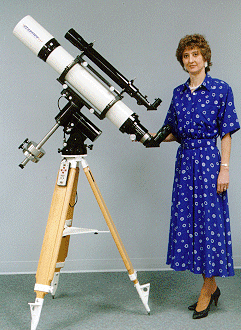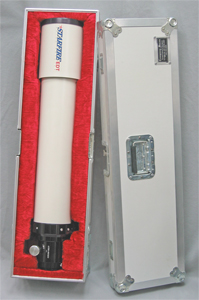Availability
![]() Distribution
Distribution
![]() News
News
![]() Notes
Notes
![]() Overview
Overview
![]() Pricing
Pricing
![]() Products
Products
Accessories and Options
![]() Mounts
Mounts
![]() Mount Control Systems
Mount Control Systems
![]() Telescopes
Telescopes

130mm f8 STARFIRE EDT REFRACTOR (5.1 "aperture)
 The 130mm f8 StarFire EDT is a very portable, lightweight refractor
with a Super ED triplet objective that is highly corrected for false
color (chromatic aberration). The color error is lese than 0.01% from
706nm to 450 nm, compared to a two element Fluorite apochromat
with 0.05%, or a Doublet Achromat with 0.45% color error over the
same spectral range. In an age when Fluorite is being marketed as the
best lens material for fast refractors, it is significant that
Astro-Physics has developed a non-Fluorite objective with 5 times
better chromatic aberration at a fraction of the cost of Fluorite.
Super ED glass (ED stands for extra low dispersion, Vd> 90) is a real
glass, not a crystal like Fluorite. ED is a harder, less fragile material
with a much lower expansion coefficient than Fluorite. Unlike
Fluorite, ED glass is not affected by atmospheric contaminants and
acids. It is for these reasons that all the world's major camera
manufacturers are incorporating ED glass into their best lenses.
The 130mm f8 StarFire EDT is a very portable, lightweight refractor
with a Super ED triplet objective that is highly corrected for false
color (chromatic aberration). The color error is lese than 0.01% from
706nm to 450 nm, compared to a two element Fluorite apochromat
with 0.05%, or a Doublet Achromat with 0.45% color error over the
same spectral range. In an age when Fluorite is being marketed as the
best lens material for fast refractors, it is significant that
Astro-Physics has developed a non-Fluorite objective with 5 times
better chromatic aberration at a fraction of the cost of Fluorite.
Super ED glass (ED stands for extra low dispersion, Vd> 90) is a real
glass, not a crystal like Fluorite. ED is a harder, less fragile material
with a much lower expansion coefficient than Fluorite. Unlike
Fluorite, ED glass is not affected by atmospheric contaminants and
acids. It is for these reasons that all the world's major camera
manufacturers are incorporating ED glass into their best lenses.
The extremely high color correction of the Super EDT design allows the construction of a relatively short-focus objective that is superior to long-focus achromats in contrast and definition of subtle planetary detail. The EDT lens is also perfectly matched to the characteristics of the fine grained Technical Pan emulsions which have their peak sensitivity at 45nm. With our matching accessories, you can create impressive astrophotos with CCD cameras, or on 35mm and 6 x 7cm film formats.
The optical design of the 130mm EDT objective consists of a positive element of ED glass surrounded by two matching hard crown meniscus lenses. The two outer elements are chosen so that the combination is free of coma, spherical aberration and other higher-order aberrations. All surfaces are spherical, which results in a very smooth overall figure. Under steady viewing conditions, you will see a hard white Airy disc at focus surrounded by the first diffraction ring. Inside and outside of focus, you will see an evenly illuminated, expanded disc with concentric Fresnel rings, the outermost ring brighter and wider than the rest. The two air-glass surfaces have multi-layer anti-reflection coatings that result in overall light transmission greater than 97% in peak visual wavelengths.
MECHANICAL CONSTRUCTION
We have incorporated several significant improvements to the tube assembly to make it easier to transport and set up in the field. The dewcap slides over the lens cell for more compact storage. An aluminum dust cover protects the optical surface when not in use, and a foam-fitted carrying case will help retain the beauty of your tube assembly for years. The tube is fully baffled and painted with light-absorbing flat black, and it features our adjustable push-pull cell.Our superb Astro-Physics focuser is a very finely crafted unit with several unique features. The components are machined on Astro-Physics' CNC to extremely high tolerances, assuring that there is no wiggle between the drawtube and housing. More than a dozen knife-edge baffles are machined into the wall of the drawtube and painted flat black in order to maximize contrast by essentially eliminating any internal reflections. We inside diameter (I.D.) of the drawtube is 2.7" which allows the avid astrophotographer to use a medium format camera to capture images in a 6 x 7cm format with minimal vignetting. You can use standard accessories with the 2" and 1.25" adapters. Recessed brass locking rings are installed at each thumbscrew location. As you tighten each thumbscrew, the brass locking ring damps onto the part that has been inserted. Consequently, your focuser drawtube and 2" and 1.25" accessories are held securely in place. This is particularly important considering the heavy and expensive accessories that you may use. As an added advantage, the brass will not mar the surface of your accessories.
PERFORMANCE
The 130mm StarFire EDT was designed to be a compact, highly portable refractor that will set up in minutes, settle down quicky and provide hours of enjoyment. It has 67% more light grasp than a 4" aperture, yet it is not much larger than many of the 4" refractors on the market today. Like the classic 5" f15 refractor, this instrument is fully capable of superb planetary performance, and yet it is only half as long. Amateurs have reported seeing the elusive Encke division on Saturn with our 5" StarFire. With a 35mm Panoptic wide angle eyepiece, we have observed the Double Cluster in Perseus. The stars were so sharp, they seemed to have no dimensions; pinpricks would have been too crude a description for their appearance. With a optional solar filter take advantage of the many hours of daylight to observe fascinating detail on the surface of the sun.The 130EDT optical design is ideal for astrophotography with small- and medium-format cameras. The widefield coverage in the 6x7 photographic format will record gorgeous images of a wide variety of objects such as the Andromeda Galaxy and the Lagoon and Trifid Nebulas. The negatives contain so much finely resolved detail that you can enlarge a small portion to feature one particular aspect of the object, i.e. the Gulf of Mexico portion of the North American Nebula. One of the finest solar eclipse photographs of the corona was taken with the 130 EDT StarFire refractor in July 1991. This photo and other deep sky photos that were taken with our 5" f8 StarFire have appeared on the cover of numerous astronomical publications around the world.
130mm f8 STARFIRE EDT SPOT DIAGRAMS FOR VISUAL WAVELENGTHS, 0.5 DEG FIELD
| SPECIFICATIONS | |
|---|---|
| Color correction: | Less than 0.01% focus variation from 706nm to 405nm |
| Clear aperture: | 130mm (5.12") |
| Focal length: | 1040mm (41") |
| Resolution: | 0.87 arc seconds |
| Coatings: | Multi-layer, overall transmission greater than 97% in peak visual wavelengths |
| Magnification range: | 18x to 500x |
| Tube assembly: | White, 5.5" aluminum tube; fully baffled, flat black interior, engraved push-pull lens cell |
| Focuser type: | 2.7" ID Astro-Physics rack and pinion focuser, 4.5" travel; 2" and 1.25" adapters; 2.5"extension |
| Telescope length: | 914mm (36") with dewcap fully retracted |
| Weight with dewcap: | 16 lbs. (7.3 kg) |
| Carrying case type: | Wooden case with grey vinyl covering and foam-lined interior |
| Case outside dimensions: | 40.5"x 9" x 9" (103cm x 23cm x 23cm) |
| Weight of empty case: | 15.5 Ibs. (7.8 kg) |
| 35mm prime-focus field: | 1.3 x 1.9 degrees @ f8 |
| 35mm telecompressor field: | 1.8 x 2.5 degrees @ f6 |
| 35mm field with 2x Barlow: | 0.7 x 0.9 degrees @ f16 |
| 6 x 7cm prime-focus field: | 3.3 x 3.9 degrees @ f8 |
FEATURES OF THE OPTICS
- Very high corrections of spherical and chromatic aberrations
- Visual and photographic focus are identical, eliminating the need for light absorbing filters
- Clear, colorfree glass types result in brighter, more contrasty images
- Stunning lunar/planetary and deep-sky views
- Ideal for 35mm and medium-format deep-sky astrophotography
- High-resolution optics are a good match for fine-grained Technical Pan emulsions
FEATURES OF THE TUBE ASSEMBLY
- Felt lined dewcap, slides over front cell for more compact storage
- Fully baffled tube and focuser assures highest contrast
- Giant 2.7" focuser with 4" travel allows coverage of 6 x 7cm formats
- 2" and 1.25" adapters with non-marring brass locking ring, with 2.5" extension
- Beautifully machined parts and expertly finished in hard polyurethane paint or black anodized
- Aluminum lens cover to protect against dust
- Sturdy foam-padded carrying case
SUGGESTIONS
Portable mount for visual and photographic studies400 German Equatorial Mount with Dual Axis Drive
Portable mount for extensive astrophotography
600 E German Equatorial Mount with Dual Axis Drive
Diagonals and Binocular Viewers:
Prism diagonals have aberrations which degrade image
quality. Since this is especially noticeable in telescopes with fast
focal ratios, we recommend the 2" Precision Mirror Diagonal.
If you use a binocular viewer (which has prisms), then place a Barlow
between the focuser and binocular viewer.
Eyepieces:
Plossls, Orthoscopics, and Widefield eyepieces show sharp
images only in the center of the field. These are fine as long as
you realize this limitation. If you object to astigmatic images at
the edge of the field, we recommend the TeleVue Nagler and
Panoptic eyepieces. These oculars have the best flat field
images and will bring out the most in your 130 StarFire EDT.
Use our 2x (2") Barlow to double your magnification.
| Eyepiece | Magnification | Actual field of view | Exit pupil |
|---|---|---|---|
| 55mm Plossol | 18x | 2.8 degrees | 7.2mm |
| 35mm Panoptic | 30x | 2.3 degrees | 4.3mm |
| 22mm Panoptic | 47x | 1.5 degrees | 2.8mm |
| 13mm Nagler | 80x | 1.0 degrees | 1.6mm |
| 9mm Nagler | 115x | 0.7 degrees | 1.1mm |
| 7mm Nagler | 148x | 0.6 degrees | 0.9mm |
| 4.8mm Nagler | 217x | 0.4 degrees | 0.6mm |

Right: Company Seven ATA Case custom fitted for a
Click on image to see enlarged view (215,942 bytes).
Features include:
- custom fit to accommodate the telescope optical tube with or without accessories (Rings, Focuser, etc.)
- hand fitted velour lining over foams of varying densities to deal with anticipated loads
- weather resistant construction
- combination lock and hasp
- Fedex/UPS label plate
- choice of interior and exterior hard shell material and colors
Left: Astro-Physics Model 900 Mount in optional Company Seven ATA case.
Please refer to the brochure for descriptions of these items and
additional accessories.
Case 1 of 2 shown here, with Declination housing (left side shown) with GTO Keypad Controller
and Counterweight Shaft (94,326 bytes).
Contents Copyright 1994-2000 Company Seven - All Rights Reserved

